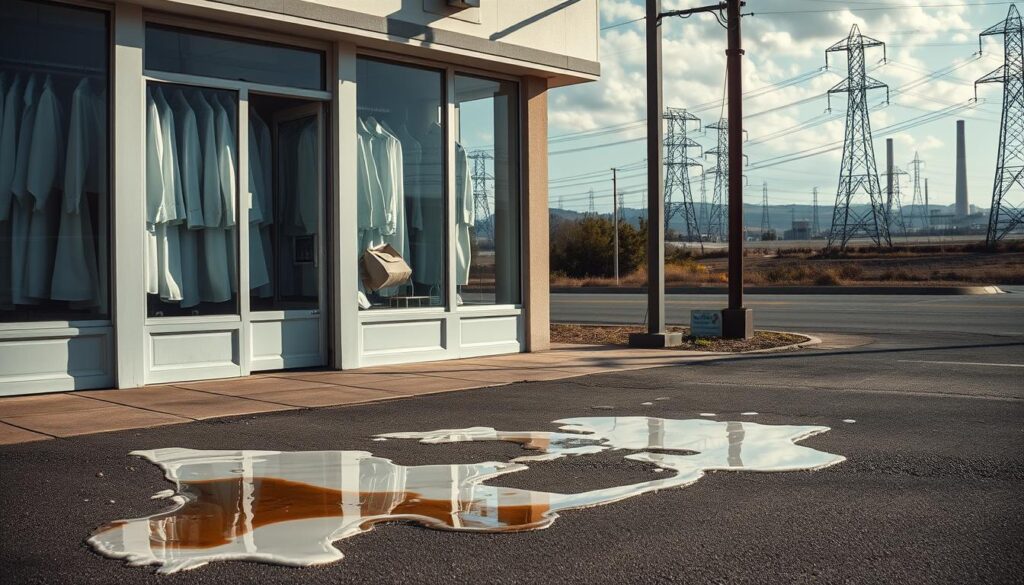Does dry cleaning protect your clothes or put them at risk? Many people wonder if this common service harms fabrics. This article cuts through the confusion, exploring whether dry cleaning myths about damage hold true or if the facts show a different story.
From suits to delicate dresses, dry cleaning is a go-to for tough stains and specialty fabrics. But with claims of shrinkage or chemical harm, it’s hard to know what’s real. We’ll uncover the truth behind these concerns and explain how to protect your wardrobe.
Key Takeaways
- Discover if dry cleaning myths about shrinking or damage are supported by dry cleaning facts.
- Learn how common fabrics respond to the process and what to avoid.
- Understand the role of chemicals used and their impact on clothing longevity.
- Find out when professional dry cleaning benefits outweigh potential risks.
- Get tips to balance cost, convenience, and care for your garments.
Understanding Dry Cleaning: How It Works
Behind the counter, dry cleaning relies on precise steps to clean delicate fabrics. Here’s how it works, from start to finish.
The Dry Cleaning Process Explained
Every garment undergoes a five-step journey: sorting, pre-treatment, cleaning, drying, and finishing. Pre-treatment involves spotting stains manually. Cleaning uses solvents to dissolve oils and dirt without water.
Solvents Used in Dry Cleaning
Solvents vary by shop. Perchloroethylene (perc) remains common but raises concerns due to its strong chemical properties. Newer options like hydrocarbon solvents and silicone-based GreenEarth® offer alternatives. Below compares their traits:
| Solvent | Effectiveness | Environmental Impact | Cost |
|---|---|---|---|
| Perchloroethylene | High | High emissions | Affordable |
| Hydrocarbon | Medium | Lower toxicity | Varies |
| GreenEarth® | Effective | Biodegradable | Premium pricing |
The Role of Equipment in Dry Cleaning
- Cleaning machines: Rotate garments in solvent baths
- Pressing units: Remove wrinkles with heat/steam
- Rotary extractors: Dry items efficiently
Equipment precision ensures garments avoid harmful effects of dry cleaning like color fading or fabric thinning. Proper machine maintenance also reduces risks to both clothes and workers.
Common Myths About Dry Cleaning Debunked
Sorting through dry cleaning mythscan feel overwhelming. This section cuts through confusion by debunking dry cleaning misconceptionsLet’s clarify facts to make smarter choices.
| Myth | Reality |
|---|---|
| Shrinks Clothes | Proper technique avoids shrinkage |
| All Fabrics Accepted | Some fabrics risk damage |
| Always Superior to Washing | Depends on fabric type |
Myth 1: Dry Cleaning Shrinks Clothes
Shrinkage usually stems from home washing mistakes, not professional care. Skilled technicians use controlled processes to preserve garment dimensions. Overloading washing machines or hot water cause more shrinkage than dry cleaning.
Myth 2: All Fabrics Can Be Dry Cleaned
Not all materials tolerate solvents. Wool and silk require precise handling, while synthetic blends like polyester can melt under harsh chemicals. Always check care labels for “dry clean only” or specific solvent warnings.
Myth 3: Dry Cleaning Is Always Better Than Washing
Home washing works for most cotton and denim. Dry cleaning shines for delicate items like wool coats or silk blouses. Over-drying or improper solvent use can harm some fabrics, making it less ideal than home care for sturdy materials.
Understanding these truths helps avoid costly mistakes. Always consult care labels and ask professionals about material-specific needs.
The Truth About Dry Cleaning Damage
Understanding the harmful effects of dry cleaning starts with knowing which fabrics face the most risk. Delving into the question, Does Dry Cleaning Actually Ruin Clothes? reveals that damage depends on material and chemical exposure. Not all garments are created equal when exposed to cleaning agents.
Fabric Types and Their Responses to Dry Cleaning
Silk, wool, and rayon may shrink or lose softness during treatment. Synthetic blends like polyester withstand processes better, while beaded embellishments or lace often fray. Delicate fabrics like cashmere may pill or fade after repeated cycles.
Chemical Reactions and Their Effects
- Perchloroethylene, a common solvent, can weaken fibers over time.
- Acidic solutions may strip natural oils from wool, causing brittleness.
- Some dyes react to chemicals, leading to color bleeding or uneven fading.
Signs of Dry Cleaning Damage
Visible clues include:
- Discolored areas or uneven fading
- Stiffness or loss of fabric flexibility
- Loose threads or unraveling seams
- Loss of original texture, like a matte finish on satin
Regular inspections after cleaning help catch issues early, preventing irreversible harm.
The Benefits of Dry Cleaning
Professional dry cleaning offers tangible advantages for maintaining wardrobe essentials. By leveraging specialized techniques, it safeguards garments while addressing complex cleaning needs efficiently.
Professional Cleaning for Delicate Fabrics

Wool, silk, and cashmere require care that home washing often fails to provide. Professional dry cleaning uses controlled processes to avoid shrinkage and maintain fabric integrity. Structured garments like tailored suits also retain their shape through methods designed to preserving clothes dry cleaning, extending their lifespan. This approach prevents damage from aggressive home techniques.
Stain Removal Capabilities
Stubborn stains from spills or everyday wear pose challenges at home. Professional dry cleaning benefits include access to solvents like perchloroethylene or silicone-based solutions that dissolve stains without harming fibers. Specialists identify stain types first, applying targeted treatments to avoid setting them permanently. For example, wine or oil-based stains often respond better to professional intervention than DIY attempts.
Time-Saving Convenience
- Expert precision: Skilled technicians handle intricate fabrics faster than time-consuming home trials.
- Bundle services: Many cleaners offer alterations, pressing, and storage tips alongside cleaning.
- Effort reduction: Drop-off services save hours spent scrubbing delicate items manually.
For frequent travelers or professionals, this convenience ensures garments are ready for events without last-minute stress. Regular use of dry cleaning services supports long-term fabric health, balancing cost with preservation value.
When to Choose Dry Cleaning Over Washing
Smart clothing care tips start with knowing when dry cleaning protects your investments. These guidelines clarify when professional cleaning ensures longevity.
Fabric Care Labels: What to Look For
Always check garment tags for instructions like “dry clean only” or “professionally dry clean.” These labels signal fabrics sensitive to water or heat. Symbols like a circle with an “X” over a washtub mean hand washing or machine washing could cause damage. Use these symbols as your guide:
- Circle symbol: Professional dry cleaning required
- Circle with letter “P”: Indicates petrochemical solvent use
- Triangle: Safe for home spot cleaning
Special Situations: Formal Wear and Costumes
Suits, wedding gowns, and elaborate costumes need dry cleaning to maintain shape and intricate details. Home washing risks damaging delicate linings, beading, or structured fabrics. Professional cleaners handle:
- Delicate embroidery or sequins
- Heavy soiling on delicate materials
- Preserving stiffened fabrics like wool or silk
Non-Clothing Items Benefiting from Dry Cleaning
Extend preserving clothes dry cleaning techniques to household items like drapes, silk upholstery, or vintage stuffed animals. Dry cleaning safely removes dust mites from heirloom quilts or restores faded upholstery without harsh agitation. Prioritize this method for:
- Velvet drapes prone to water stains
- Leather furniture needing deep cleaning
- Antique textiles with fragile dyes
Alternatives to Traditional Dry Cleaning
Exploring eco-friendly methods and smart home solutions can help maintain clothes without relying solely on dry cleaning. These options balance environmental impact, cost, and effectiveness while preserving garment quality.
Eco-Friendly Dry Cleaning Options
Modern extending garment lifespan starts with eco-friendly processes. Dry cleaners using liquid carbon dioxide or silicone-based solvents like GreenEarth’s siloxane replace perc (perchloroethylene), reducing chemical exposure. Wet cleaning, a water-based method, works well for wool and silk, minimizing environmental harm while maintaining fabric integrity.
Home Dry Cleaning Kits: Do They Work?
- Products like Dryel or Woolite’s Dry Cleaner’s Secret offer convenience for light soiling.
- Best for lightly worn garments; avoid heavily stained items.
- Cost-effective for occasional use but may not tackle tough stains.
Washing at Home: Best Practices
Proper clothing care tips extend fabric longevity. Follow these steps:
| Tip | Action | Benefit |
|---|---|---|
| Hand-washing | Use lukewarm water + mild detergent | Prevents shrinkage |
| Cold-water cycles | Use delicates setting on washing machines | Maintains fabric shape |
| Air-drying | Lay garments flat or use low-heat settings | Avoids heat damage |
Matching care labels with these methods ensures fabrics stay durable and vibrant longer.
Frequency of Dry Cleaning: How Often Is Enough?
Proper dry cleaning frequency ensures clothes stay durable while avoiding excess costs. Smart scheduling protects fabric integrity and saves money. These clothing care tips help tailor cleaning to each item’s needs.
Factors Influencing Dry Cleaning Frequency
- Wear frequency: Garments worn daily (like suits) may need cleaning every 3-5 wears.
- Material type: Delicate fabrics like silk or wool require more frequent care.
- Odors or stains: Perspiration or spills demand prompt attention to prevent buildup.
- Storage duration: Items stored long-term should be cleaned before packing to avoid moth damage.
Seasonal Clothing Considerations
Winter coats and sweaters often need cleaning after 3-4 wears due to body oils. Light summer fabrics like linen can go 5-10 wears unless soiled. Transition pieces like trench coats may need mid-season cleaning. Always clean before storing seasonal items to extend their lifespan.
Balancing Cost and Care
Prioritize high-value items like designer dresses or tailored suits for regular dry cleaning. Use home spot treatments for minor stains to reduce visits. For everyday wear, air garments overnight between uses to cut down frequency. This approach lowers costs while maintaining extending garment lifespan.
Dry Cleaning and Its Environmental Impact

The harmful effects of dry cleaning stem from traditional chemicals used in the process. Dry cleaning facts show many facilities still rely on solvents like perchloroethylene (perc), which can pollute water and air if improperly managed. Newer methods aim to balance care and sustainability.
Chemicals and Their Effects on the Environment
- Perchloroethylene (perc) harms ecosystems if leaked into soil or water
- Older solvents contribute to indoor and outdoor air pollution
- Waste disposal creates long-term contamination risks
Sustainable Practices in the Industry
| Traditional Methods | Sustainable Alternatives |
|---|---|
| Perc-based solvents | Hydrocarbon or CO₂ systems |
| High energy consumption | Energy-efficient machinery |
| Limited recycling | Closed-loop solvent recovery systems |
Consumer Considerations for Eco-Friendly Choices
Ask dry cleaners about:
- Certifications (GreenEarth, EcoCert)
- EPA compliance status
- Recycling programs for hangers/bags
Reduce frequency by spot-cleaning stains at home first. Opt for home-washable fabrics when possible.
Tips for Choosing a Dry Cleaner
Professional dry cleaning benefits depend on selecting a skilled provider. Start by visiting the location. Clean facilities and knowledgeable staff are key indicators of reliability. Ask if they pre-inspect garments and use quality-control steps like steam pressing or colorfastness tests.
Key Qualities to Evaluate
- Certifications: Look for eco-certifications like GreenEarth or Ozone-3
- Damage history: Request examples of repaired garments
- Communication: Staff should explain processes clearly
Reading Reviews Wisely
Customer reviews reveal patterns. Prioritize feedback mentioning:
| Red Flags | Positive Signs |
|---|---|
| Repeated shrinkage complaints | Stain removal success rates |
| Guarantee disputes | Woolmark or Care Label Program endorsements |
Questions to Ask
Ask these critical questions during your visit:
- “What solvents do you use?” (Avoid perchloroethylene)
- “How do you handle delicate fabrics like silk?”
- “What’s your process for pre-treating stains?”
- “What’s your satisfaction guarantee?”
Debunking dry cleaning misconceptions starts with informed choices. Reputable cleaners openly share their methods and stand behind their work. Prioritize transparency to unlock the full professional dry cleaning benefits for your wardrobe.
Cost Considerations: Is Dry Cleaning Worth It?
Choosing between dry cleaning and home washing involves more than just price tags. Professional care might cost more upfront, but it often extends garment lifespan and protects delicate fabrics. Let’s break down costs and long-term savings.
Average Costs of Dry Cleaning Services
Pricing varies by location and item type. Here’s a snapshot of typical rates in the U.S.:
| Item | Average Cost |
|---|---|
| Cotton Shirts | $5–$15 |
| Suits | $20–$40 |
| Dresses | $10–$25 |
| Formal Wear | $30–$60+ |
Comparing Dry Cleaning to Traditional Cleaning
- Upfront Cost: Dry cleaning costs 2–5x more than home washing.
- Longevity: Proper dry cleaning preserving clothes reduces frequent replacements, saving money over time.
- Specialty Fabrics: Delicate materials like silk or wool require professional care to avoid damage, making it a cost-effective choice long-term.
Budgeting for Dry Cleaning Regularly
Smart strategies help manage expenses without sacrificing care:
- Target High-Value Items: Focus on preserving clothes like wedding gowns or tailored suits that justify the cost.
- Seasonal Plans: Schedule cleanings seasonally instead of monthly to cut frequency.
- Look for Discounts: Many cleaners offer loyalty programs or off-peak discounts.
Viewing dry cleaning as a preservation investment—rather than a recurring cost—shifts the focus to long-term savings through extending garment lifespan.
Conclusion: Making Informed Choices for Your Clothes
Choosing the right care for your garments starts with separating dry cleaning myths from proven practices. This guide has explored how to protect your wardrobe while avoiding common misunderstandings.
Recap of Myths vs. Facts
Popular dry cleaning myths like “all fabrics shrink” or “home washing is always worse” have been addressed. Evidence shows proper techniques minimize damage. Knowing care labels and material specifics helps avoid costly mistakes.
Final Thoughts on Fabric Care
Effective fabric care requires balancing professional services with at-home maintenance. Regular spot cleaning, proper storage, and understanding garment composition prevent premature wear. Dry cleaning is just one tool in a broader care strategy.
Encouragement to Research and Ask Questions
Stay informed by researching debunking dry cleaning misconceptions through trusted sources. Ask professionals about eco-friendly options or solvent types. Prioritizing material guidelines ensures longevity and aligns care choices with personal and environmental values.


1 thought on “Does Dry Cleaning Actually Ruin Clothes? Myths vs. Facts”
Comments are closed.